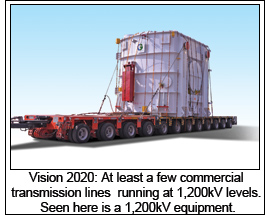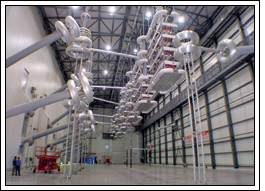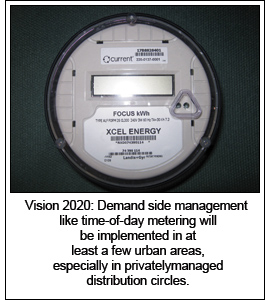
Over the past decade or so, the electrical equipment
and power sector has seen sweeping changes
resulting in a radical metamorphosis of the
industry. Much of this has been possible due to a liberal
policy environment that has encouraged sustainable
participation of the private sector. In this prognostic study,
Electrical Monitor briefly discusses some key milestones
that the electrical equipment and power industry is
expected to cross by the year 2020.
Tariff-based bidding: By 2020, one can look forward to
a robust mechanism governing the extant tariff-based
bidding process. Although the process is very much in
vogue today, success stories have only been sporadic. There
have already been instances where power developers are
very apprehensive of selling power at the specified tariffs
due to factors unforeseen at the time of bidding and now
beyond their control. As we go along, we can expect that
the policy framework addresses such anomalies swiftly
without stalling the project progress. In conjunction, India
would also need to bolster its machinery in according
environmental clearances, coal linkages and other preproject
clearances in a time-bound manner. Only this
would result in more projects being readied for the
awarding stage. Assuming that the government's
machinery to facilitate projects is sufficiently galvanized,
one can expect traction in the ultra mega power project
(UMPP) series that is currently stumbling with only four
projects awarded in the seven years of its launch. By 2020,
the UMPP series can be an important means to augment
power generation capacity with significant technocommercial
efficiency and a relatively lower carbon
footprint.
Supercritical Technology: Despite India's efforts to
enhance power generation from non-fossil energy sources,
its dependence on coal-fired plants to base load will persist.
The approach therefore is to make coal-fired power
generation more sustainable through use of efficiency
measures like supercritical technology. India has already
made a beginning with supercritical technology with a few
power plants (by Adani Power and NTPC) already in their
early days of operation. Currently, the technology is largely
sourced from overseas with Chinese players dominating
the proceedings.
By 2020, one can safely expect all upcoming coal-fired
power plants to be based on supercritical power
technology. The government has set out an official
expectation that in the XIII Plan period (FY18 to FY22) all
new coal-fired power plants will be based on supercritical
technology. One can also assume that by 2020, India would
have developed indigenous capability to manufacture supercritical power equipment. Currently, there are
around six joint ventures between Indian companies and
multinationals to set up local plants for producing
supercritical boilers, and turbine-generators. By 2020, most
of these should have fructified. One can also expect this to
result in a decline in imported power generation
equipment, mainly from China. On this point, one can also
assume that the import duty structure will have been
corrected to create a level-playing field between Indian and
foreign equipment.
National Grid: Power Grid Corporation of India Ltd has
embarked on an inter-regional transmission system to
enable seamless transfer of power across the five regional
grids of the country. The National Grid is seen as an
important tool to ensure efficient load management
between power-surplus and power-deficient regions. The
National Grid, with a total capacity of 37,500 mw, was
envisaged for full completion by March 2012 but is running
behind schedule by around two years.
By 2020, the National Grid will of course be completed
and one can also look forward to substantial increase in its
handling capacity. As of March 2012, the total capacity of
the National Grid stood at around 28,000 mw with
additions in the XI Plan period (FY08 to FY12) alone being
13,900 mw.
The National Grid envisages synchronous transmission
(at the same frequency) of power between the five regional
grids—east, west, north, northeast and south. Currently, all
grids except the southern grid are interconnected. The
southern grid is connected, but asynchronously (at different
frequency) with the rest of the grid. This has been achieved
through HVDC links and radially-operated AC links.
It may also be noted that the National Grid is also
important on two counts—one, deployment of advanced
technology like 765kV infrastructure, and two,
involvement of private sector as owners and developers of
transmission lines.
 Distribution transformers:
Distribution transformers: The Indian transformer
industry has two extremities. On the one hand, the
country has demonstrated its abilities to indigenously
produce power transformers of 1,200kV—the highest
rating in the world. On the other, it has the highest failure
rate—of over 25 per cent—with respect to distribution
transformers. For 2020, a realistic expectation would be to
see substantial mitigation in the anarchy prevailing in the
distribution transformer industry.
Apart from the malady of inferior CRGO (that has been
discussed separately), flawed procurement policies of state
power utilities are a matter of grave concern. Currently,
much of the government procurement is done through the
L1 philosophy where the equipment is purchased from the
suppliers quoting the lowest. It is this myopic practice that
has spawned a breed of unscrupulous manufacturers. If by
2020, government procurement policies undergo a radical
transformation—that is they look clearly beyond just L1—
much of the house will fall in order.
Also, state government utilities should at least try to
standardize their transformer specifications. This will
enable domestic manufacturers to achieve economies of
scale. Currently, transformer manufacture is a highly
customized activity.
It is also expected that by 2020, the star-labeling
programme of Bureau of Energy Efficiency is implemented
strongly for distribution transformers. It is not reasonable to expect that all distribution transformers pressed into
public service to have the highest efficiency rating.
Through stringently implemented policy measures,
India, by 2020, should rid itself of unethical distribution
transformer manufacturers. This can be done only by
devising and enforcing an overarching policy framework
that destroys the very demand for inferior distribution
transformers.
CRGO: India has traditionally had a difficult time with
electrical steel—specifically cold rolled grain oriented steel
(CRGO) that is a critical input for transformers. Firstly, the
country has consistently failed to set up domestic
manufacturing capacity making reliance on imports
inevitable. To compound matters, India has become a
dumping ground for inferior CRGO that finds its way—
sometimes willfully and sometimes inadvertently—into
transformers. The government is in the process of
mandating that foreign mills intending to supply CRGO to
India must ensure that their products have the "BIS
certification". This move is technically sound but will not
be easy to implement. Some mills have registered under the
scheme while others are in the process.
By 2020, one expects that the CRGO issue is resolved.
There could be no better news for the Indian transformer
industry that has the dubious distinct of having the highest
distribution transformer failure rate in the world. The
vision for 2020 would be the emergence of domestic
manufacturing capacity and a sharp decline in the use of
imported scrap CRGO.
Cable Technology: As carriers of electricity, cables are
the quintessence of power T&D infrastructure. Cables
could range from EHV cables are used in sub-transmission
and distribution, up to building wires & cables that are
used in providing last-mile connectivity to the wall socket.
By 2020, one can expect key changes in the industry that
could include a radical shift in the technology paradigm
and the gradual easing out of marginal players in the
building/home wiring segment.
India has a significant presence of unorganized sector
players in the home wiring segment that includes cables of
less than 1.1kV rating. These companies, thanks to the
alleged use inferior copper and insulating material, can sell
their products very cheap. Further, they cater only to the
local market—usually tier-III cities and towns—thus
keeping their distribution costs at the minimum. Players in
the organized sector find it unviable to even compete with
these local brands on the price front. It is estimated that 30
per cent of the low-tension cables consumed in India are
from unorganized sector players. However, due to growing
quality consciousness of consumers, the hold of marginal
players is expected to loosen and their share is expected to
fall to less than 10 per cent by 2020.
In terms of new technology, India is expected to make
significant progress in the local manufacture of extra highvoltage
(EHV) cables, those with a rating of 220kV. By
2020, India would have 8-10 domestic players—most of
them with foreign technical collaborations—making EHV
cables. Even as of now, at least two players have acquired
competence in producing 400kV EHV cables.
In the coming years, EHV cables will begin to find
deployment largely as a replacement to overhead power
distribution lines. More and more utilities will be seen
shifting to underground EHV cables. If India's success rate
with privatization of power distribution is high, usage of
underground EHV cables will be even more intense given
the private sector's predisposition towards modern
technology. As India's EHV cable consumption begins to
grow, one can also anticipate competition by way of
imports. China is expected to lead price-based competition
as it has done to other segments of the electrical equipment
industry.
 High-voltage transmission:
High-voltage transmission: India's ongoing
experiments in using 1,200kV ultra-high voltage for power
transmission are being viewed keenly by the world. Last
year, India achieved a rare technological distinction by
successfully conducting the test run for 1,200kV power
transmission on a 1-km line at Bina in Madhya Pradesh. So
far, no other country has succeeded in transmitting power
at 1,200kV. Countries like China and Russia are believed to
have commercial power transmission lines of around
1,000kV.
The 1,200kV endeavour is a joint exercise between Central transmission utility Power Grid Corporation of
India Ltd and leading equipment manufacturers like
Siemens, ABB, Alstom, Vijai Electricals Ltd. The response
of Indian manufacturers to produce 1,200kV equipment
like transformers, reactors, circuit breakers, etc has been
outstanding. It must be appreciated that producing
equipment without known standards is a much more
challenging job than replicating something that has
essentially been produced somewhere in the world.
By 2020, one can look forward to India stabilizing the
commercial viability of 1,200kV technology. Currently, the
success with 1,200kV transmission has been setting up and
testing the pilot project. Even the competence for
producing equipment and accessories has been established,
largely with respect to the pilot project. Commercial
operations will be a different paradigm altogether. Experts
feel that the way forward for India would be set up few
commercial lines to begin with. These will not be charged
at the highest voltage, at the very onset. Experts feel that
the way to go forward would be to set up 1,200kV lines but
charge them at 400kV initially, and move up gradually.
Commercial deployment will be a gradual process but one
can be sure that by 2020, India would have sufficient
demonstrable signs of progress. Apart from 1,200kV, India,
by 2020, will have achieved considerable stability in EHV
power transmission like 765kV AC and 800kV DC.
If one looks at the geographical aspect of India's power
generation and consumption, one can see that power
generation centres (east and northeast) are very distinct
from consumption zones (west, north and south India).
India has no alternative but to use transmission lines that
can transfer more electricity per unit geographical area. By
2020, India will show technical competence and sufficient
commercial success in its high-voltage transmission
infrastructure.
It is also expected that by 2020, Indian testing
laboratories like CPRI, ERDA, etc will be equipped to test
high-voltage equipment for which the country is currently
banking on testing labs abroad.
Power Distribution: The power distribution sector is
almost entirely responsible for the current dismal state of
the Indian power sector. Years of decadence have
snowballed into a financial catastrophe, which cannot be
remedied in a hurry. For 2020, the only vision that one can
have for the ailing power distribution segment is to initiate
a serious multi-pronged solution strategy to bring about an
honest improvement to the current morass. While one
must admit that there has been a sincere attempt by the
government in treating the wounds of the power
distribution sector, the progress has been slow. There have
been enough policies announcements, all aimed at
"reforming" the sector, but the pace of implementation has
fallen seriously short of expectations. Every area of power
distribution—be it as rudimentary as village electrification
or as futuristic as Smart Grid—has been touched upon by
the government. This must be clearly acknowledged.
However, the achievement record has belied expectations.
For 2020, here is a wish list on various aspects of the power
distribution segment.
- The much celebrated "Power for All" milestone was to
be crossed by March 2012 and complete village
electrification was the quintessence of this objective. India
is now expected to achieve 100 per cent village
electrification very shortly; the project is officially 97 per
cent complete. By 2020, rural electrification is expected to
intensify further. This means that villages that have been
declared electrified technically will see more households
getting electrified. (By latest definition, a village is declared
electrified if, among other things, at least 10 per cent of the
households have an electricity connection.) On the way to
2020, one can also expect 100 per cent electrification but
with the threshold household electrification limit
progressively being raised from the current 10 per cent.
- India's current aggregate technical and commercial
(ATC) losses in the power sector are estimated at an
alarming 25 per cent. It is an abjectly shameful metric for a developing country; even under-developed countries have
significantly lower losses. Much of these losses are
commercial in nature, resulting from poor revenue
collections. This in turn is due to power theft, unaccounted
electricity meters, under-recovery of dues from consumers,
etc. The vision for 2020 should be lowering the ATC losses
to more respectable levels—say around 10 per cent—as is
the case with most developed countries. Lowering ATC
losses could initiate a virtuous cycle where power utilities
will become financially stronger. This is will result in more
capital investment, only to mean better infrastructure and
services for consumers.
By 2020, it is hoped that utilities distribution are in better
financial health for which Centrally-sponsored programmes
like R-APDRP (Part A) should be pursued vigorously. This
project involves setting up of IT-enabled infrastructure like
GIS mapping of assets, consumer indexing, etc. This project
too is lagging behind its targeted completion date of March
2012. As far as the vision for 2020 is concerned, it would be
only fair to expect that every power distribution utility
(hopefully most of them are privatized by then) should have
complete knowledge of its assets, consumers and of every
kwh of electricity consumed.
- When we speak of private sector participation in the
power sector, one can only think of power generation. In
the other two major departments—transmission and
distribution—the progress has been wavering. Power
generation—both conventional and renewable energy —
has seen significant private and foreign sector investment.
In fact, renewable energy is an activity designed to run
entirely on private enterprise. Regarding power
transmission, a beginning has been made but there has
been no demonstrable progress. Power distribution is
struggling with privatization. India has traditionally had
some private power utilities like Tata Power, BSES (now
RInfra), Ahmedabad Electricity (now taken over by
Torrent), CESC, etc. However, the success rate of
privatization of power distribution in recent years has been
poor with only Delhi (North Delhi Power, BSES Yamuna
and BSES Rajdhani) being notable exceptions.
Privatization of power distribution has resulted in huge
benefits to the consumer, and the government is very
cognizant of this. However, for reasons that could include
weak political will, the process of privatizing power
distribution has not acquired the desired momentum. In
recent times, privatization of the circles of Kanpur, Agra
and Nagpur, could be completed but not before
encountering major hurdles.
As a vision for 2020, one can only hope that the
government is able to garner enough political will to
propagate the culture of privatization of power
distribution. The atrophied power distribution sector
urgently needs private sector managerial efficiency and it
would be in national interest to see loss-making power
distribution circles being expeditiously brought under the
private sector ambit.
- India has taken initial steps in bringing in the futuristic
Smart Grid technology. The Smart Grid Task Force
appointed last year is expected to gain some traction in the
coming years and by 2020, one can expect India to have
achieved some demonstrable progress on the Smart Grid
front. For one, the pilot Smart Grid project that Power Grid
Corporation of India is implementing in Puducherry is
expected to be commissioned. This will be a useful
benchmark to establish India's technical competence with
elementary infrastructure that would go into commercial
Smart Grids in future. Apart from this, one can expect that
India is able to create enabling infrastructure that would
form the basis of the future Smart Grid.
What one could expect with a fair degree of confidence is
that by 2020 all electric connections would be equipped
with Smart Grid-enabled meters. These meters would offer
basic Smart Grid facilities like time-of-day (also referred to
as time-of-usage) metering. A pilot project to this effect has
already been proposed in some areas of Delhi, and it is likely
that all power distribution circles that are under private
sector management will at least have ToD metering in
place by 2020.
Another important expectation that one could have for
2020 is significant progress in setting standards for goods
and services relating to Smart Grid. Organisations like
IEEE-SA are actively involved in this exercise and one can
look forward to tangible results by 2020.

Solar Energy: The government has embarked on the
Jawaharlal Nehru National Solar Mission (JNNSM) that
envisages as much as 20 GW by 2020. For a country that
had barely 1 mw of grid-connected solar power capacity
before the mission was launched in 2010, this is a very
ambitious target. Currently, India's solar capacity (gridconnected)
is over 1 GW and much of this has come from
projects under the solar mission. Apart from the JNNSM,
various states like Gujarat, Rajasthan and Karnataka are
running their own solar power programmes.
Over the recent past, solar power tariffs have dropped
very sharply - from an average of Rs.12.16 per kwh in JNNSM (Batch I) to around Rs.8.77 per kwh in Batch II.
Very recently, one developer even quoted Rs.6.45 per kwh
for a project in Rajasthan, which industry circles believe is
the lowest tariff quoted ever.
For the solar power industry, one can expect that by the
year 2020, tariffs were progressively drop thanks to capital
equipment (mainly photovoltaic) getting cheaper by the
day. However, there are some international trends that
need to be considered. India is considering imposing antidumping
duties on solar cells and modules imported from
China and USA. Further, China is also pursuing a
mammoth solar power programme that might propel
domestic consumption of solar equipment.
India would need to move towards building a
manufacturing base if it needs to have better control over
costs of solar power generation. In the years leading up to
2020, India could be seen making the groundwork for
indigenous production of solar cells. Apart from gridconnected
solar plants, India will also see progress in
standalone solar power installations that would help
electrify remote villages where reaching grid power would
be technically and commercially unviable.
 Wind Energy:
Wind Energy: This has been the mainstay of India's
renewable energy pursuits. Today, around 75 per cent of
India's renewable energy capacity of some 26 GW comes
from wind energy. During the period 2010 to 2012, India
could add 2.5 GW of new wind power capacity on average -
a sharp increase over the 1.6 GW that it did during the
period 2006 to 2009. However, wind power capacity
addition appears to be heading for a slowdown as the
government is contemplating withdrawal of fiscal benefits
like generation-based incentives and accelerated
depreciation. The government is attempting to make wind
power an avenue of green power generation more than a
means to avail tax breaks. Curbing of fiscal incentives is
ostensibly to weed out the "non-serious" players.
By 2020, one can expect a robust framework on the
policy front, especially measures that ensure that wind
energy is an exercise in "power generation" and not just
"capacity addition". India could also be seen making
progress in the direction of re-powering of turbines, which
means replacing low-rating turbines installed in the early
days by high-rating ones. Over the next few years, turbines
of ratings of 3-mw or higher could mark their presence.
This could result in higher capacity without additional
geographical footprint. The period from now to 2020 could
also see India beginning to explore the possibilities of
offshore wind farms. Wind energy will also be seen
contending with solar power that is currently in the
government's sharp focus.
Energy Efficiency: With India's power consumption
expected to grow by at least 7 per cent annually over the
next 10-15 years, there are bound to be constraints over fuel
security. Though inexhaustible energy sources like the sun
and wind are expected to make a significant contribution,
the core energy needs will continue to come from fossilbased
sources.
India would need to therefore bring in greater amount of
efficiencies both in the way power is generated and in the
way it is consumed. Use of fossil fuels will have to be done
in a way that there is no compromise on India's carbon
footprint. At the same time, consumers must ensure that
electricity is used up in the most efficient manner. By 2020,
both generators and consumers will have become
increasingly conscious of energy efficiency.
While efficiency in power generation will come largely
from technological advances, efficiency in consumption
will come out of demand-side management. In terms of
power generation from fossil fuels, technologies like ultra
supercritical coal-based power generation, coal
gasification, etc.
By 2020, India is expected to take up demand side
management on a serious note. In this context, usage of
energy efficient appliances will be of utmost importance.
Lighting that consumes an estimated 20 per of the total
electricity consumption will have undergone a major
transformation. Traditional lighting devices like
incandescent lamps will be discarded making way for CFL
and even LED lighting. By then, technology would have
pushed down prices of these products substantially.
The Bureau of Energy Efficiency that is setting standards
for energy-efficient appliances will have a greater role to
play in the coming years. More and more appliances will
have come under mandatory certification for energy
efficiency. Along with this, enforcement of energy
efficiency standards will also have improved significantly.
By 2020, one can also expect that some urban centres will
have commercial Smart Grids in operation, even if they
offer elementary capabilities. The facility of Time of Day or
Time of Usage metering will be a very important feature of
demand side management. Pilot projects for ToD metering
have been initiated in cities like Delhi, and by 2020, one can
look forward to ToD metering put into practice by a
significant number of cities, going a long way towards
demand side management.